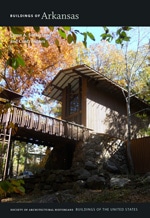Libraries today serve many more purposes than their historic roles as places for reading, research, and borrowing books. They have become comprehensive learning centers with computers, discussion areas, performance and art rooms, gardens, and spaces for a variety of community activities for people of all ages, including children, as here. Before the architects began their design for this library they organized a charrette for the neighborhood’s children to express their thoughts and needs. That discussion revealed that the children wanted a place that was inspirational, was full of natural light, and felt safe and sheltered, and it became clear that food security was a significant daily concern. These needs and wishes guided the design. Site conditions influenced the library’s shape, a parallelogram of thirty thousand square feet on six acres of abandoned land next to I-630, the highway that in the 1970s sliced through the African American neighborhoods of Little Rock. The theme of shelter is conveyed by the exposed truss carrying a flat roof with a slight uptilt. On the west and north sides, the roof extends fifteen feet to shelter the glass and native stone building and provide shady porches. The different materials and structural clarity of the library’s forms and materials were planned to be instructive in themselves by illustrating construction and mechanical methods and systems. As well as filling the interior with natural light, the transparency of the glass walls acts as an invitation to enter, communicating welcome. When the interior is illuminated at night, the building stands as a beacon in the neighborhood. The landscaping includes a greenhouse, kitchen garden, and a teaching kitchen for food preparation. Walking paths wind through an informal section of the garden planted with trees and plants native to the entire state, while other areas of the landscaping are more formal, including an allée of trees. The garden also includes a wetland, with pools on the north and west sides of the building that capture runoff from the highway and form a security barrier for the site. This LEED Gold building thus also instructs about water and energy efficiency and conservation.
You are here
Hillary Rodham Clinton Children’s Library and Learning Center
If SAH Archipedia has been useful to you, please consider supporting it.
SAH Archipedia tells the story of the United States through its buildings, landscapes, and cities. This freely available resource empowers the public with authoritative knowledge that deepens their understanding and appreciation of the built environment. But the Society of Architectural Historians, which created SAH Archipedia with University of Virginia Press, needs your support to maintain the high-caliber research, writing, photography, cartography, editing, design, and programming that make SAH Archipedia a trusted online resource available to all who value the history of place, heritage tourism, and learning.









